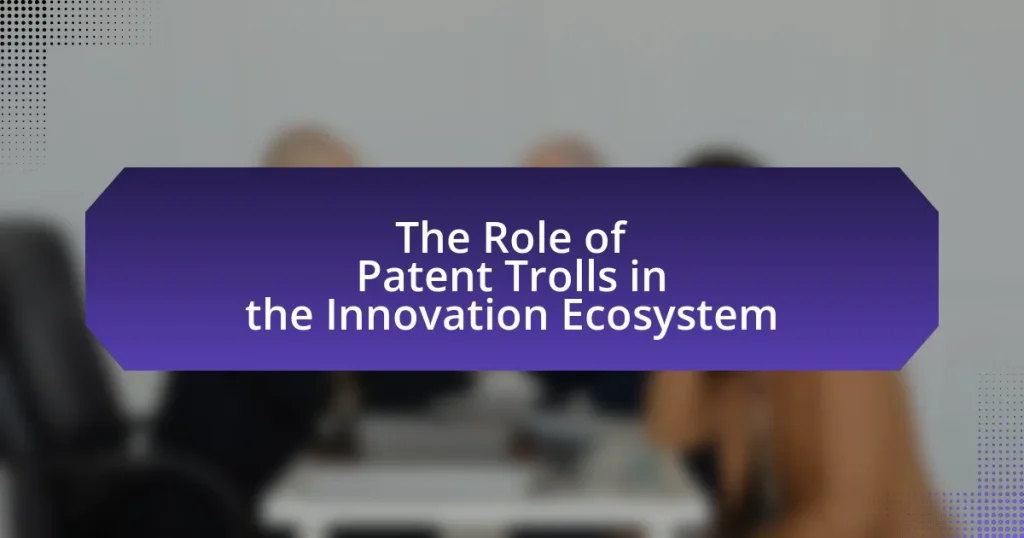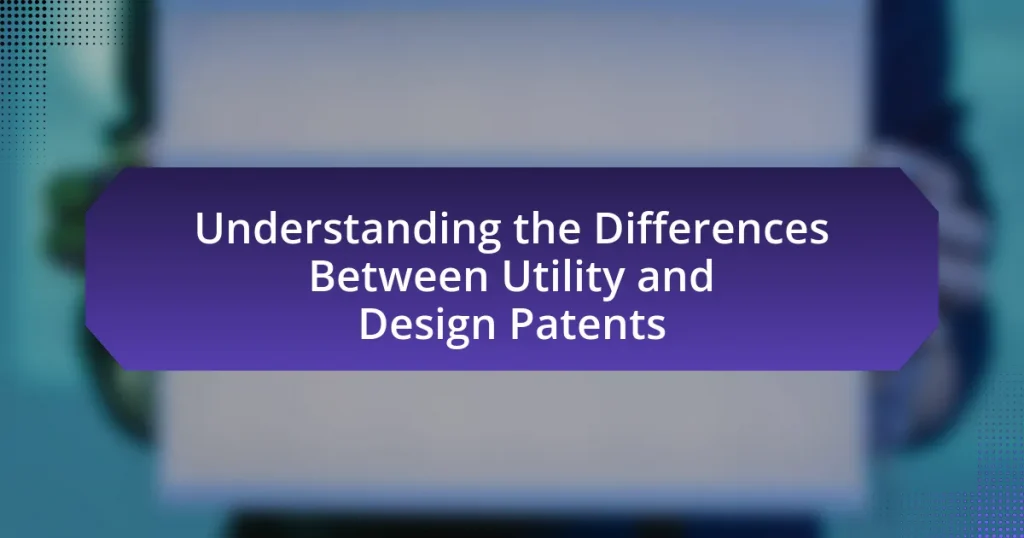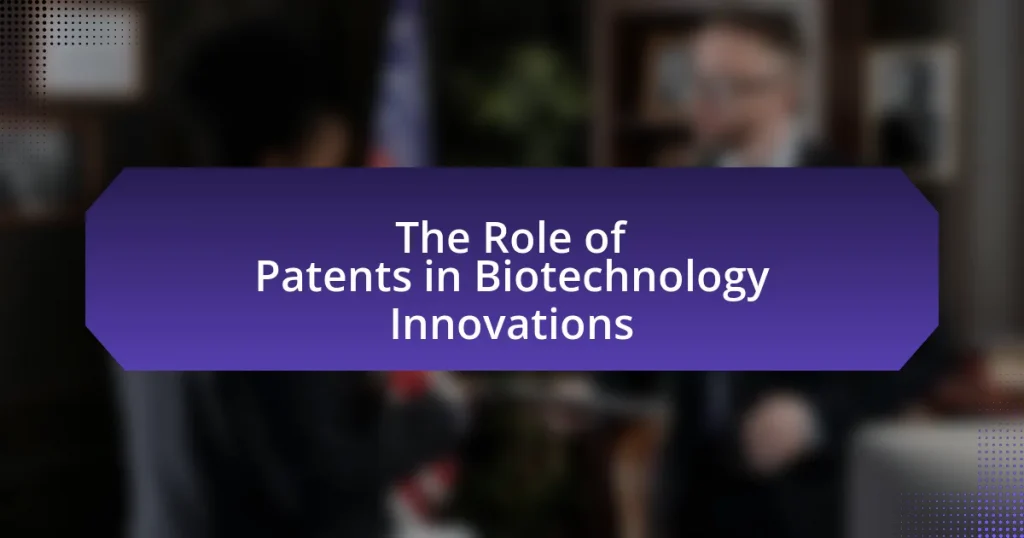Patent law is a legal framework that grants inventors exclusive rights to their inventions, playing a crucial role in promoting innovation within renewable energy technologies. The article explores how patent law influences the development of renewable energy by providing legal protection that encourages investment and research. Key principles such as novelty, non-obviousness, and utility are discussed, along with the competitive advantages patents offer to companies in the renewable energy sector. Additionally, the article addresses challenges related to patent disputes, international patent law, and strategies for companies to effectively navigate the patent landscape, ultimately highlighting the significance of patent law in advancing sustainable energy solutions.
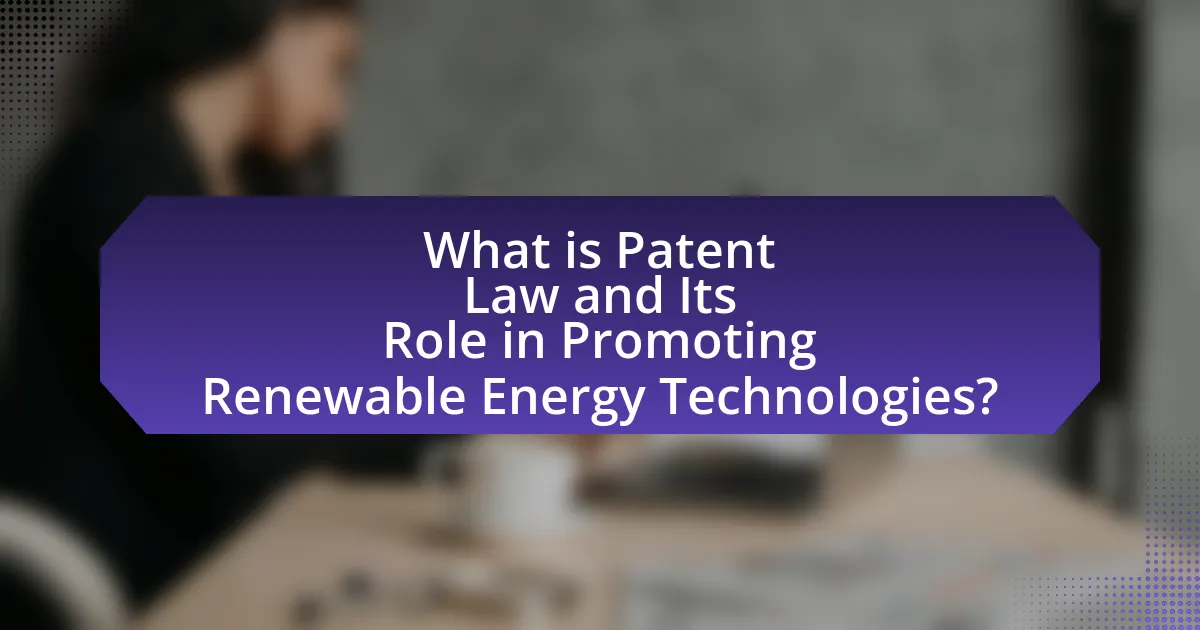
What is Patent Law and Its Role in Promoting Renewable Energy Technologies?
Patent law is a legal framework that grants inventors exclusive rights to their inventions for a limited time, thereby incentivizing innovation. This legal protection encourages the development of renewable energy technologies by allowing inventors and companies to secure investments and recover research and development costs. For instance, the U.S. Patent and Trademark Office reported that patents in renewable energy sectors, such as solar and wind, have significantly increased, reflecting a growing interest in sustainable technologies. By providing a competitive edge, patent law fosters an environment where new and improved renewable energy solutions can emerge, ultimately contributing to the transition towards a more sustainable energy future.
How does patent law influence innovation in renewable energy?
Patent law significantly influences innovation in renewable energy by providing legal protection for inventions, which incentivizes research and development. This protection allows inventors and companies to secure exclusive rights to their innovations, thereby encouraging investment in new technologies. For instance, the U.S. Patent and Trademark Office reported that patents in renewable energy technologies, such as solar and wind, have increased by over 50% in the last decade, indicating a direct correlation between patent protection and innovation activity. By safeguarding intellectual property, patent law fosters a competitive environment where companies are motivated to innovate, ultimately leading to advancements in renewable energy solutions.
What are the key principles of patent law relevant to renewable energy?
The key principles of patent law relevant to renewable energy include novelty, non-obviousness, and utility. Novelty requires that the invention must be new and not previously disclosed to the public, which is crucial for protecting innovative renewable energy technologies. Non-obviousness mandates that the invention must not be an obvious improvement to someone skilled in the field, ensuring that only truly innovative solutions receive patent protection. Utility stipulates that the invention must have a specific, substantial, and credible utility, which is particularly relevant in demonstrating the practical applications of renewable energy technologies. These principles collectively encourage innovation in the renewable energy sector by providing legal protection and incentives for inventors to develop new technologies.
How do patents protect renewable energy technologies?
Patents protect renewable energy technologies by granting inventors exclusive rights to their inventions for a specified period, typically 20 years. This exclusivity incentivizes innovation by allowing inventors to recoup research and development costs without the immediate threat of competition. For example, the U.S. Patent and Trademark Office reported that patents in the renewable energy sector have increased significantly, reflecting a growing investment in technologies like solar and wind energy. By securing intellectual property rights, patents encourage the development and commercialization of new renewable energy solutions, ultimately contributing to advancements in sustainability and energy efficiency.
Why is patent protection important for renewable energy companies?
Patent protection is crucial for renewable energy companies because it secures exclusive rights to innovations, enabling them to recoup research and development investments. This exclusivity fosters innovation by providing a competitive edge in a rapidly evolving market, where companies can protect their technological advancements from imitation. For instance, according to the World Intellectual Property Organization, patenting renewable energy technologies can lead to increased investment, as investors are more likely to fund projects with protected intellectual property. This legal framework not only incentivizes the development of new technologies but also contributes to the overall growth of the renewable energy sector by ensuring that companies can monetize their innovations effectively.
What competitive advantages do patents provide in the renewable energy sector?
Patents provide significant competitive advantages in the renewable energy sector by granting exclusive rights to inventors, which fosters innovation and investment. These exclusive rights prevent competitors from using, making, or selling the patented technology without permission, thereby allowing patent holders to establish market dominance and secure a return on investment. For instance, companies like Tesla have leveraged patents to protect their advancements in battery technology, enabling them to maintain a competitive edge in the electric vehicle market. Additionally, patents can attract funding and partnerships, as investors are more likely to support projects with protected intellectual property, evidenced by the increase in venture capital investments in renewable energy startups that hold patents.
How do patents affect investment in renewable energy technologies?
Patents significantly influence investment in renewable energy technologies by providing legal protection for innovations, which encourages investors to fund research and development. When companies secure patents, they gain exclusive rights to their inventions, reducing the risk of competition and enabling them to recoup their investments. For instance, a study by the International Renewable Energy Agency (IRENA) found that countries with strong patent systems attract more foreign direct investment in renewable energy sectors. This correlation highlights that robust patent protections can lead to increased financial backing for new technologies, fostering innovation and market growth in the renewable energy landscape.
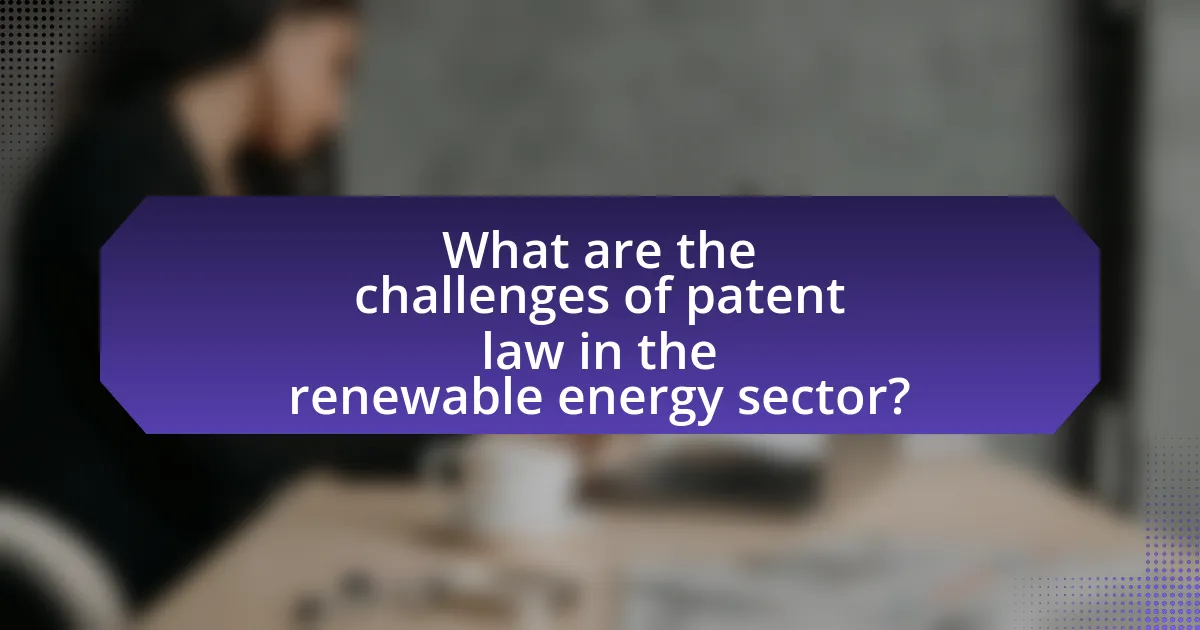
What are the challenges of patent law in the renewable energy sector?
The challenges of patent law in the renewable energy sector include the rapid pace of technological innovation, which often outstrips the patent application process, leading to delays in protection. This situation can result in companies being unable to secure exclusive rights to their inventions, thereby discouraging investment in new technologies. Additionally, the complexity of existing patent frameworks can create barriers for small and medium enterprises, which may lack the resources to navigate the patent system effectively. Furthermore, the global nature of renewable energy markets complicates enforcement, as patent laws vary significantly between jurisdictions, leading to potential conflicts and uncertainties in protecting intellectual property.
How do patent disputes impact the development of renewable energy technologies?
Patent disputes significantly hinder the development of renewable energy technologies by creating barriers to innovation and increasing costs for companies. These disputes often lead to lengthy legal battles, which can delay the introduction of new technologies to the market. For instance, a study by the International Renewable Energy Agency (IRENA) found that patent litigation can result in a 20% increase in development costs and a delay of up to three years in bringing new renewable energy solutions to consumers. Furthermore, the uncertainty surrounding patent rights can discourage investment in research and development, as companies may be reluctant to invest in technologies that could be subject to litigation. This ultimately stifles competition and slows the advancement of renewable energy technologies essential for addressing climate change.
What are common types of patent disputes in the renewable energy field?
Common types of patent disputes in the renewable energy field include infringement claims, validity challenges, and licensing disagreements. Infringement claims arise when one party alleges that another party is using patented technology without permission, often seen in solar panel and wind turbine technologies. Validity challenges occur when a party disputes the originality or enforceability of a patent, which can happen in bioenergy and energy storage sectors. Licensing disagreements typically involve disputes over the terms and conditions of patent licenses, frequently encountered in the development of innovative renewable energy solutions. These disputes can significantly impact the advancement and commercialization of renewable energy technologies.
How can companies navigate patent disputes effectively?
Companies can navigate patent disputes effectively by implementing a proactive strategy that includes thorough patent analysis, negotiation, and alternative dispute resolution methods. Conducting a comprehensive review of existing patents helps identify potential infringements and assess the strength of their own patents. Engaging in negotiations with the opposing party can lead to settlements that avoid lengthy litigation, which is often costly and time-consuming. Additionally, utilizing mediation or arbitration can provide a more efficient resolution compared to traditional court proceedings. According to a study by the World Intellectual Property Organization, companies that engage in early dispute resolution mechanisms can reduce litigation costs by up to 50%.
What role does international patent law play in renewable energy innovation?
International patent law significantly influences renewable energy innovation by providing a framework that encourages investment in research and development. This legal structure protects inventors’ rights, ensuring that they can reap the financial benefits of their innovations, which is crucial in the capital-intensive renewable energy sector. For instance, the World Intellectual Property Organization (WIPO) reports that patenting renewable energy technologies has increased, indicating that inventors are leveraging international patent systems to secure their innovations globally. This protection fosters collaboration and knowledge sharing across borders, ultimately accelerating the development and deployment of renewable energy solutions.
How do different countries approach patenting renewable energy technologies?
Different countries approach patenting renewable energy technologies through varying legal frameworks and incentives. For instance, the United States emphasizes a strong patent system that encourages innovation by providing a 20-year exclusivity period for inventions, which has led to significant advancements in solar and wind technologies. In contrast, the European Union promotes a more collaborative approach, integrating sustainability into its patent policies and offering grants for green technology innovations, as seen in the European Patent Office’s initiatives. Meanwhile, countries like China have rapidly increased their patent filings in renewable energy, reflecting a strategic focus on becoming a global leader in this sector, with over 70,000 renewable energy patents filed by 2020. These diverse approaches illustrate how national policies can shape the development and commercialization of renewable energy technologies.
What are the implications of international treaties on renewable energy patents?
International treaties significantly influence renewable energy patents by establishing a framework for intellectual property protection across borders. These treaties, such as the Agreement on Trade-Related Aspects of Intellectual Property Rights (TRIPS), create standardized rules that enhance patent protection, encouraging innovation in renewable energy technologies. For instance, countries that adhere to these treaties are required to provide a minimum level of patent protection, which can lead to increased investment in research and development. Additionally, international treaties facilitate technology transfer by allowing patent holders to license their innovations globally, thereby accelerating the adoption of renewable energy solutions. This interconnectedness fosters collaboration among nations, ultimately contributing to global efforts in combating climate change and promoting sustainable energy practices.
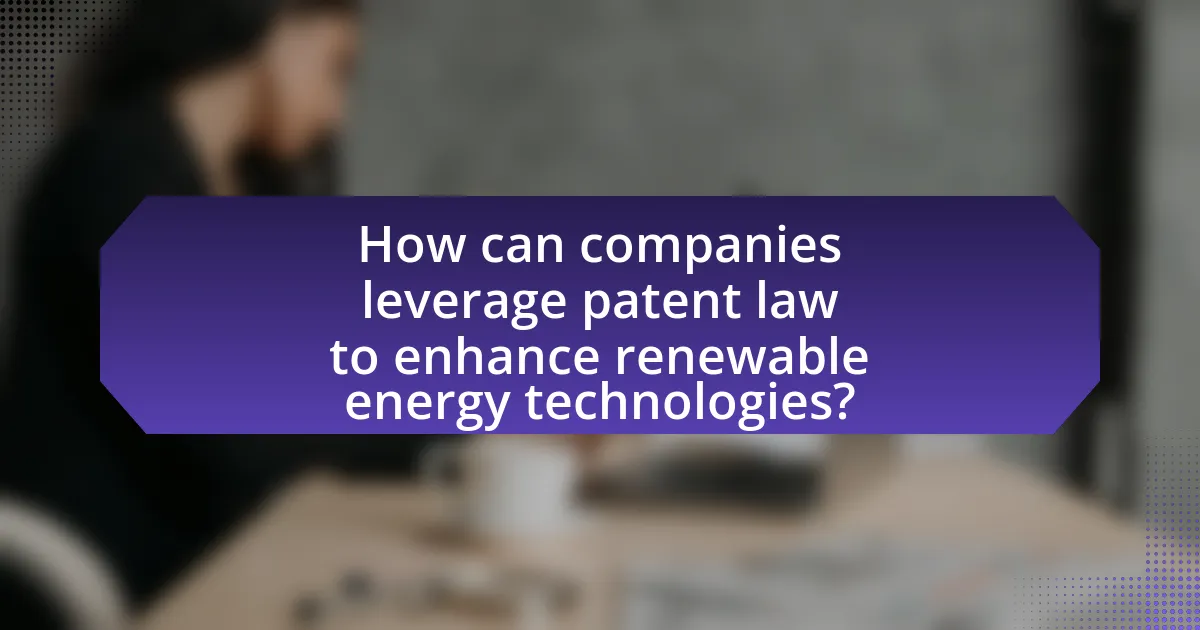
How can companies leverage patent law to enhance renewable energy technologies?
Companies can leverage patent law to enhance renewable energy technologies by securing exclusive rights to their innovations, which incentivizes investment in research and development. By obtaining patents, companies can protect their technological advancements from competitors, ensuring a competitive edge in the market. For instance, the International Renewable Energy Agency reported that patenting activity in renewable energy technologies has increased significantly, indicating that companies are actively using patents to safeguard their innovations. This legal protection allows firms to attract funding, collaborate with other entities, and commercialize their technologies effectively, ultimately driving progress in the renewable energy sector.
What strategies can companies adopt to maximize their patent portfolios?
Companies can maximize their patent portfolios by implementing a comprehensive strategy that includes regular portfolio audits, targeted innovation, and strategic partnerships. Regular audits help identify underperforming patents, allowing companies to focus on high-value assets and eliminate redundancies. Targeted innovation involves aligning research and development efforts with market needs and emerging technologies, ensuring that patents are relevant and commercially viable. Strategic partnerships, such as collaborations with universities or other firms, can enhance innovation capabilities and provide access to new technologies, further strengthening the patent portfolio. According to a study by the World Intellectual Property Organization, companies that actively manage their patent portfolios can increase their market competitiveness and revenue potential significantly.
How can companies identify patentable innovations in renewable energy?
Companies can identify patentable innovations in renewable energy by conducting thorough market research, analyzing existing patents, and leveraging technological advancements. This process involves assessing the novelty and non-obviousness of their innovations against current patents in databases such as the United States Patent and Trademark Office (USPTO) and the European Patent Office (EPO). For instance, the USPTO reported over 1,000 patents granted in solar energy technologies in 2022, indicating a competitive landscape where unique innovations can be identified. Additionally, companies can collaborate with research institutions to explore cutting-edge developments, ensuring their innovations meet the criteria for patentability, which includes being useful, novel, and non-obvious.
What best practices should companies follow for patent filing and management?
Companies should follow a structured approach to patent filing and management that includes conducting thorough prior art searches, maintaining accurate documentation, and establishing a clear strategy for patent portfolio management. Conducting prior art searches helps identify existing patents and technologies, reducing the risk of infringement and ensuring the novelty of the invention. Accurate documentation throughout the invention process is crucial for establishing ownership and supporting patent claims, as evidenced by the fact that 70% of patent applications face rejections due to inadequate documentation. A clear strategy for managing the patent portfolio, including regular reviews and assessments of patent value, ensures that companies can effectively leverage their intellectual property for competitive advantage.
What are the future trends in patent law affecting renewable energy technologies?
Future trends in patent law affecting renewable energy technologies include increased emphasis on sustainability and innovation, as well as the potential for streamlined processes for patent applications. Patent offices are likely to adopt more flexible criteria for evaluating renewable energy patents, encouraging the development of green technologies. Additionally, there is a growing trend towards international harmonization of patent laws, which can facilitate cross-border collaboration in renewable energy innovation. These trends are supported by initiatives from organizations like the World Intellectual Property Organization, which promotes the integration of environmental considerations into intellectual property frameworks.
How might changes in patent law influence renewable energy innovation?
Changes in patent law can significantly influence renewable energy innovation by altering the incentives for research and development. For instance, more stringent patent protections may encourage companies to invest in new technologies by ensuring that their innovations are safeguarded from competition, thereby fostering a more robust pipeline of renewable energy solutions. Conversely, loosening patent restrictions could facilitate greater collaboration and knowledge sharing among researchers and companies, potentially accelerating the pace of innovation. Historical evidence shows that countries with supportive patent frameworks, such as Germany, have seen substantial advancements in renewable technologies like solar and wind energy, highlighting the critical role of patent law in shaping innovation landscapes.
What emerging technologies in renewable energy are likely to shape patent law?
Emerging technologies in renewable energy that are likely to shape patent law include advanced solar photovoltaic materials, energy storage systems like solid-state batteries, and hydrogen fuel cell technology. These innovations are driving significant changes in patent law due to their unique characteristics and the rapid pace of development. For instance, advanced solar materials, such as perovskite solar cells, present new challenges in patentability due to their novel compositions and manufacturing processes. Similarly, the evolution of energy storage technologies necessitates new patent strategies to protect intellectual property in a competitive market. The hydrogen fuel cell sector is also evolving, prompting discussions on patent rights related to production methods and applications. These technologies are reshaping the landscape of patent law by introducing complexities in defining prior art and determining the scope of patent protection.
What practical steps can companies take to navigate patent law in renewable energy?
Companies can navigate patent law in renewable energy by conducting thorough patent searches, filing for patents early, and engaging in strategic partnerships. Conducting patent searches helps identify existing patents and avoid infringement, which is crucial given that the renewable energy sector is rapidly evolving and highly competitive. Filing for patents early secures intellectual property rights and can enhance a company’s market position, as evidenced by the increase in patent filings in solar and wind technologies, which rose by 20% from 2018 to 2020 according to the World Intellectual Property Organization. Engaging in strategic partnerships with research institutions or other companies can facilitate knowledge sharing and access to new technologies, thereby strengthening a company’s patent portfolio and innovation capabilities.

